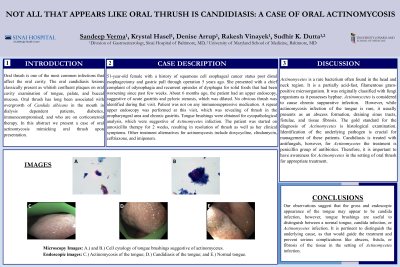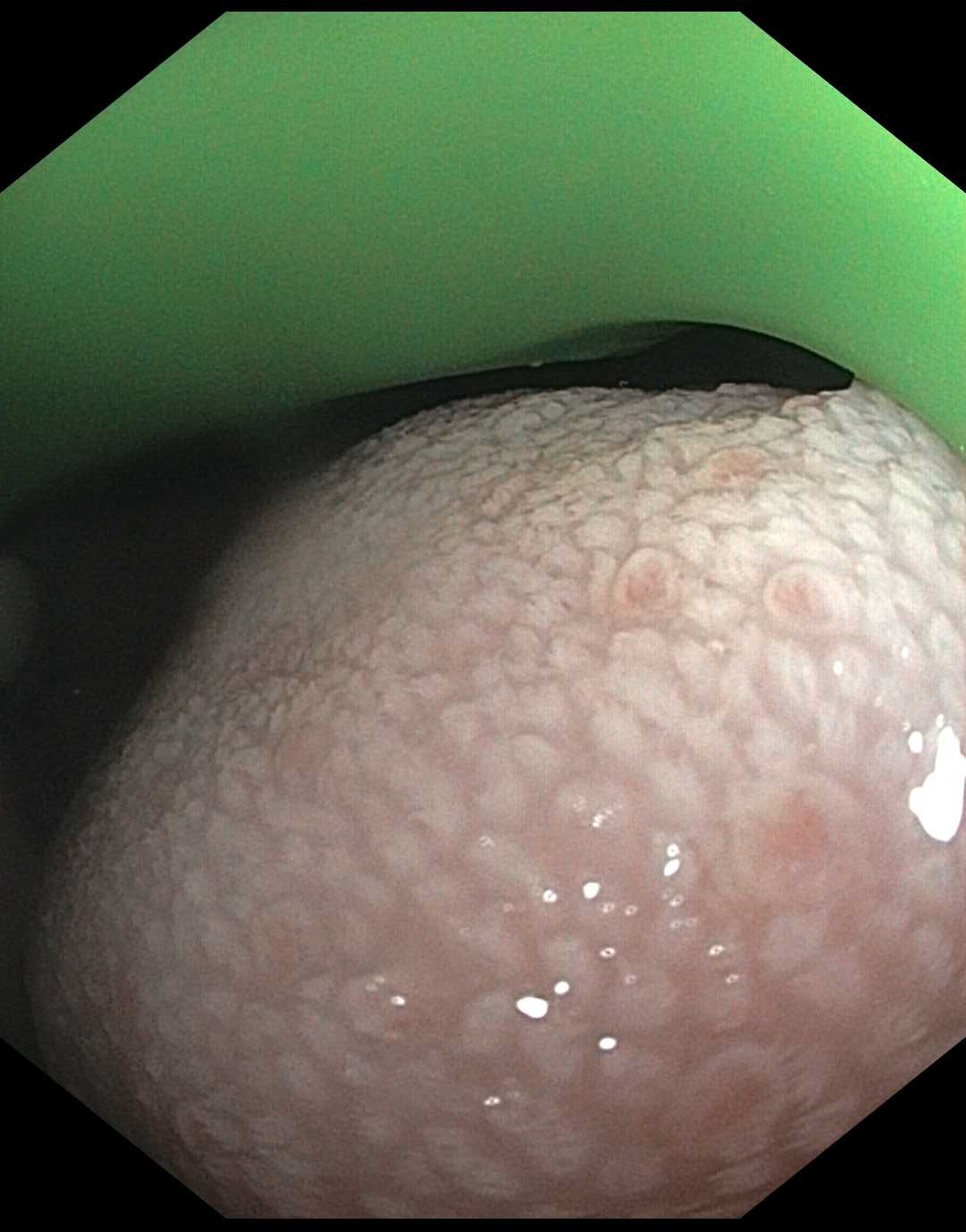Back

Poster Session B - Monday Morning
Category: General Endoscopy
B0305 - Not All That Appears Like Oral Thrush Is Candidiasis: A Case of Oral Actinomycosis
Monday, October 24, 2022
10:00 AM – 12:00 PM ET
Location: Crown Ballroom


Sandeep Verma, MBBS, MD
Sinai Hospital
Baltimore, MD
Presenting Author(s)
Sandeep Verma, MBBS, MD1, Krystal Hasel, MD1, Dennise Arrup, RN1, Rakesh Vinayek, MD, FACG1, Sudhir K. Dutta, MD, FACG2
1Sinai Hospital, Baltimore, MD; 2Sinai Hospital/ University of Maryland School of Medicine, Baltimore, MD
Introduction: Oral thrush is one of the most common infections that affect the oral cavity. The oral candidiasis lesions classically present as whitish confluent plaques on oral cavity examination of tongue, palate, and buccal mucosa. Oral thrush has long been associated with overgrowth of Candida albicans in the mouth in dialysis dependent patients, diabetics, immunocompromised, and who are on corticosteroid therapy. In this abstract we present a case of oral actinomycosis mimicking oral thrush upon presentation.
Case Description/Methods: 51-year-old female a history of squamous cell esophageal cancer status post distal esophagectomy and gastric pull through operation 5 years ago. She with a presented with a chief complaint of odynophagia and recurrent episodes of dysphagia for solid foods that has been worsening since past few weeks. About 6 months ago the patient had an upper endoscopy, which was significant for acute gastritis and pyloric stenosis, which was dilated. No obvious thrush was identified during that visit. Patient was not on any immunosuppressive medication. A repeat upper endoscopy was performed at this visit which was revealing of thrush in the oropharyngeal area and chronic gastritis. Tongue brushings were obtained for cytopathological analysis, which were suggestive of actinomyces infection. The patient was started on amoxicillin therapy for 2 weeks, which resulted in resolution of thrush as well as her clinical symptoms. Other treatment alternatives for actinomycosis include doxycycline, clindamycin, ceftriaxone, and imipenem.
Discussion: Actinomyces is a rare bacterium often found in the head and neck region. They are partially acid-fast, filamentous gram-positive microorganisms. They were originally classified with fungi organisms as they possess hyphae. Actinomyces is considered to cause chronic suppurative infection. However, actinomycosis infection of the tongue is rare, it usually presents as an abscess formation, draining sinus tracts, fistulae, and tissue fibrosis. The gold standard for the diagnosis of Actinomyces is histological examination. Identification of the underlying pathogen is crucial for management of these patients. Candida is treated with antifungals, however, for actinomyces the treatment is penicillin group of antibiotics. Therefore, it is important to have awareness for actinomyces in the setting of oral thrush for appropriate treatment.

Disclosures:
Sandeep Verma, MBBS, MD1, Krystal Hasel, MD1, Dennise Arrup, RN1, Rakesh Vinayek, MD, FACG1, Sudhir K. Dutta, MD, FACG2. B0305 - Not All That Appears Like Oral Thrush Is Candidiasis: A Case of Oral Actinomycosis, ACG 2022 Annual Scientific Meeting Abstracts. Charlotte, NC: American College of Gastroenterology.
1Sinai Hospital, Baltimore, MD; 2Sinai Hospital/ University of Maryland School of Medicine, Baltimore, MD
Introduction: Oral thrush is one of the most common infections that affect the oral cavity. The oral candidiasis lesions classically present as whitish confluent plaques on oral cavity examination of tongue, palate, and buccal mucosa. Oral thrush has long been associated with overgrowth of Candida albicans in the mouth in dialysis dependent patients, diabetics, immunocompromised, and who are on corticosteroid therapy. In this abstract we present a case of oral actinomycosis mimicking oral thrush upon presentation.
Case Description/Methods: 51-year-old female a history of squamous cell esophageal cancer status post distal esophagectomy and gastric pull through operation 5 years ago. She with a presented with a chief complaint of odynophagia and recurrent episodes of dysphagia for solid foods that has been worsening since past few weeks. About 6 months ago the patient had an upper endoscopy, which was significant for acute gastritis and pyloric stenosis, which was dilated. No obvious thrush was identified during that visit. Patient was not on any immunosuppressive medication. A repeat upper endoscopy was performed at this visit which was revealing of thrush in the oropharyngeal area and chronic gastritis. Tongue brushings were obtained for cytopathological analysis, which were suggestive of actinomyces infection. The patient was started on amoxicillin therapy for 2 weeks, which resulted in resolution of thrush as well as her clinical symptoms. Other treatment alternatives for actinomycosis include doxycycline, clindamycin, ceftriaxone, and imipenem.
Discussion: Actinomyces is a rare bacterium often found in the head and neck region. They are partially acid-fast, filamentous gram-positive microorganisms. They were originally classified with fungi organisms as they possess hyphae. Actinomyces is considered to cause chronic suppurative infection. However, actinomycosis infection of the tongue is rare, it usually presents as an abscess formation, draining sinus tracts, fistulae, and tissue fibrosis. The gold standard for the diagnosis of Actinomyces is histological examination. Identification of the underlying pathogen is crucial for management of these patients. Candida is treated with antifungals, however, for actinomyces the treatment is penicillin group of antibiotics. Therefore, it is important to have awareness for actinomyces in the setting of oral thrush for appropriate treatment.

Figure: Endoscopic Findings
Disclosures:
Sandeep Verma indicated no relevant financial relationships.
Krystal Hasel indicated no relevant financial relationships.
Dennise Arrup indicated no relevant financial relationships.
Rakesh Vinayek indicated no relevant financial relationships.
Sudhir K. Dutta indicated no relevant financial relationships.
Sandeep Verma, MBBS, MD1, Krystal Hasel, MD1, Dennise Arrup, RN1, Rakesh Vinayek, MD, FACG1, Sudhir K. Dutta, MD, FACG2. B0305 - Not All That Appears Like Oral Thrush Is Candidiasis: A Case of Oral Actinomycosis, ACG 2022 Annual Scientific Meeting Abstracts. Charlotte, NC: American College of Gastroenterology.

